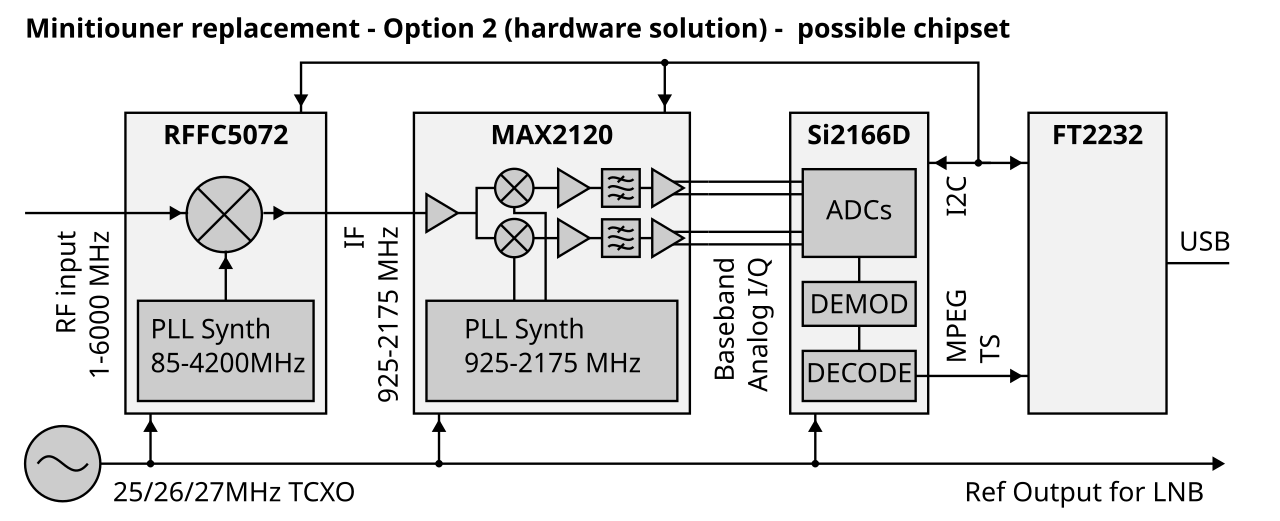Well, having gone this far down this rabbit hole, I might as well propose a complete solution, at least for the purposes of further discussion.
I had a look at available zero-IF receiver ICs that might be used with the Si2166 demodulator. Unfortunately the STV6120 used in the Serit 4334 is really quite unique in being rated down to 250MHz input, let alone in its ability to be pushed out of spec to both 145MHz and 2450MHz. At GSG, we recently experimented with pushing some similar parts beyond their official limits, and didn't get anywhere near as far as that.
So I think the most promising option would be to accept the use of some readily available receiver IC, with its limited tuning range, and combine it with a wideband frontend mixer in order to increase the tuning range of the overall design. This rules out a simple three-chip design (receiver, demodulator and USB interface), but is possible with only one extra chip, by using a part that combines both a wideband mixer and an I2C-controlled frequency synthesizer for the LO.
Here's a rough high-level sketch of what I have in mind, with some part choices that I think might be particularly attractive:

- concept.png (109.48 KiB) Viewed 623869 times
This takes one extra chip compared to the MiniTiouner architecture, but could provide "DC to daylight" coverage, supporting direct reception of every DATV band from 29Mhz to 5.7GHz, plus higher frequencies via an external LNB.
All these parts are capable of running from a common reference clock in the 20-30MHz range, so a single high-quality TCXO could be used as the basis for the entire receive path, including reference injection to an external LNB if desired.
The ~1GHz tuning range of the MAx2120 allows for a wide choice of LO and IF for a given receive frequency, and therefore a lot of options for IF filter arrangements. I've left filtering and RF amplification out of the diagram due to the range of approaches possible.
Some commentary on the specific parts:
RFFC5072
This is the same frontend mixer we use in HackRF One, and is well-proven in that design all the way from 1MHz to 6GHz. It has full public documentation, and there is open source code for controlling it in the HackRF firmware. Some baluns would be required around this mixer to match its differential input/output ports to single-ended 75 ohm; I have not included these on the diagram, but there should be straightforward solutions possible. The conversion loss of the mixer itself is only around 2dB, which may be low enough to avoid the need for an amp at the RF input in many scenarios.
MAX2120
There are quite a few zero-IF receiver ICs of similar specification that could be used here, and we looked at a number of them for the receive side of the
URTI project. The MAX2120 had notably better availability and lower cost than others. There is a full public datasheet for it. Mike Ossmann did some testing of this part on its evaluation board, and his results can be seen
here. He was able to push the tuning range to 499 MHz to 2442 MHz; not that there is any need to do so in this design. The simplest plan for the IF range would be to select a single preferred frequency, clear of most likely interference, and include a tight bandpass filter around it.
Si2166D
As per notes earlier in the thread, this demodulator is known from the Octagon SF8008 to work down to at least 100kS/s symbol rates if not lower, and there is open source reference code for it from the manufacturer. The full datasheet is not public, but there are probably sufficient clues between the reference code and the SF8008 implementation to use it successfully.
FT2232
I'm assuming this can be reused from the MiniTiouner design with few changes provided that the MPEG-TS interface is similar. All the above parts are controllable over I2C.
Prototyping
The least certain and highest-risk part of this design is the Si2166D, for which there is only partial public documentation. A relatively easy way to prototype this part of the system, without any RF design work needed, would be to create a board with the Si2166D and FT2232 parts only, and connect this to the analog baseband pins on the P9 header of a HackRF One. This would allow using the RFFC5072 and MAX2837 on the HackRF to stand-in for the mixer and MAX2120 chip on the proposed design.
If there is interest in pursuing something like this approach I'd be happy to help further with it.